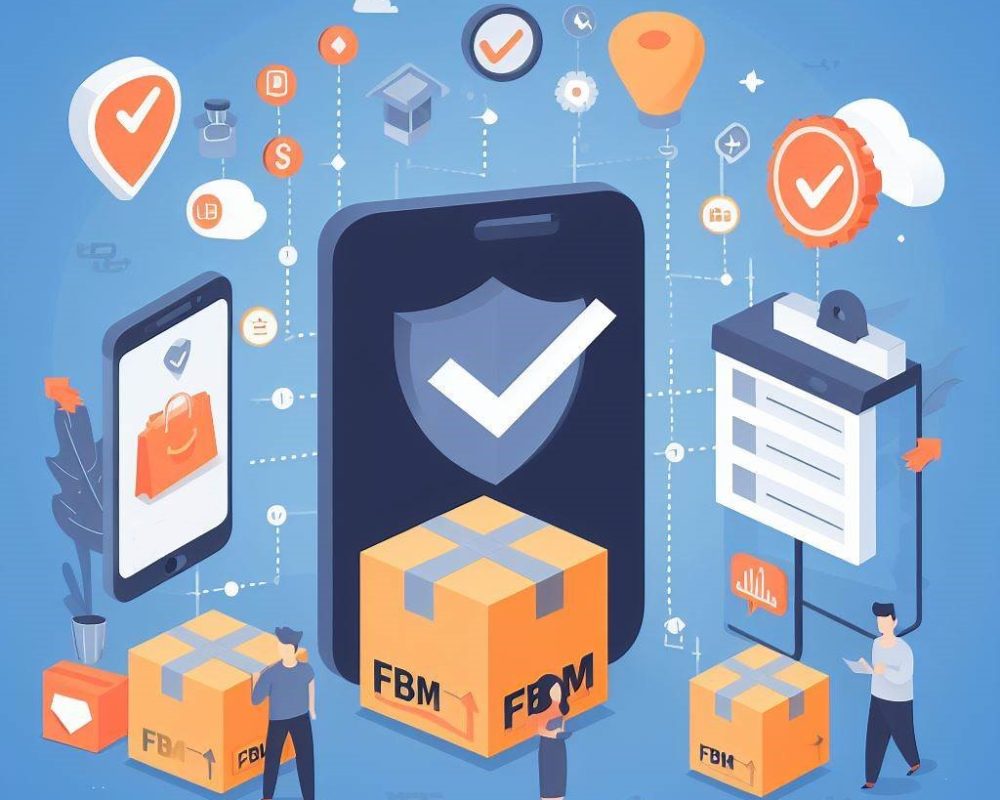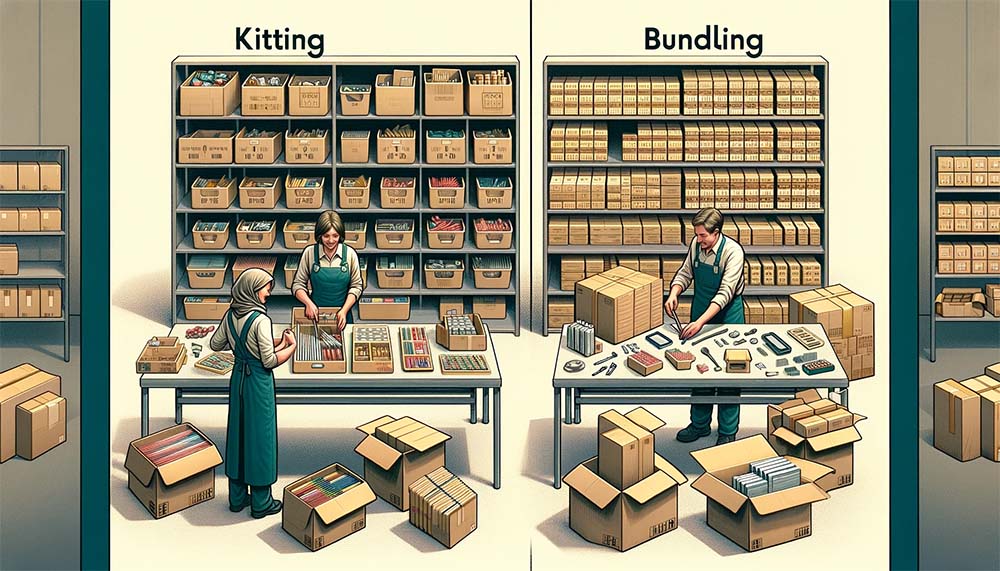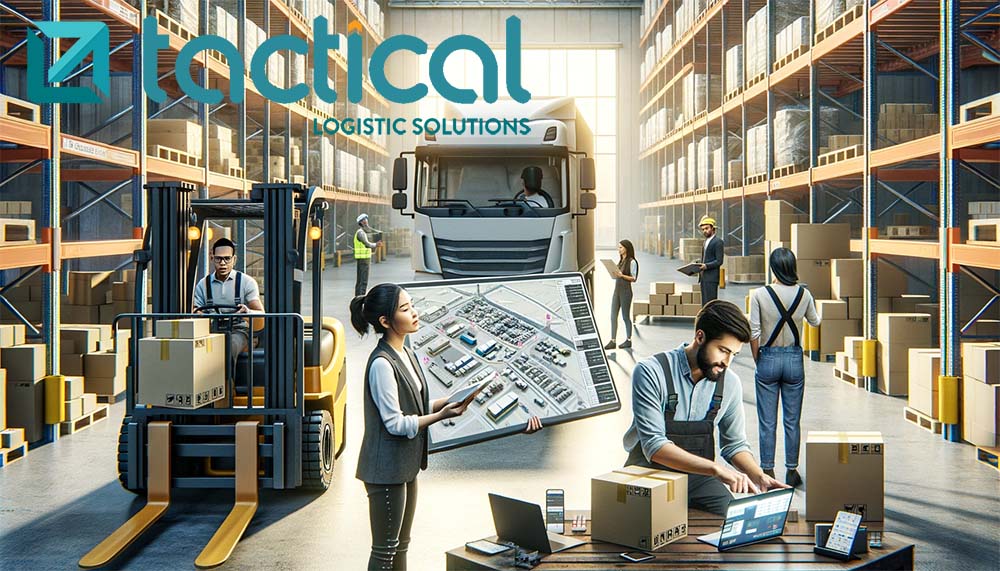What Is 3PL Kitting? How To Apply It To Your ECommerce Business.

Table of Contents
Kitting in logistics is a powerful process that combines individual items into one package, offering benefits for both manufacturers and retailers. Whether it’s material kitting for manufacturing or product kitting for shipping and packing, the use of 3PL kitting services can greatly enhance efficiency and customer satisfaction.
By utilizing third-party logistics kitting, businesses can enjoy shorter lead times, reduced overhead costs, and improved inventory management. This comprehensive guide will provide valuable insights into the world of 3PL kitting, its advantages, and how it works.
Key Takeaways:
- 3PL kitting combines individual items into one package for sale or streamlined production efficiency.
- Kitting helps decrease fabrication times, improve assembly efficiency, reduce the risk of errors, and streamline inventory management.
- Using 3PL kitting services can provide benefits such as shorter lead times, reduced overhead costs, fewer errors, and improved customer service.
- The process starts with collecting required parts, quality checking them, and assembling them into kits.
- Outsourcing kitting services to a 3PL provider allows businesses to focus on core competencies and provide faster, better service to customers.
What is 3PL Kitting and How Does it Work?
3PL kitting is a process that involves outsourcing kitting services to a third-party logistics provider. This service is utilized by businesses to combine multiple like items into a single package that is marketed and sold as one item. The 3PL kitting process begins with the collection of all the required parts, which are stored on an as-needed basis, reducing warehouse space requirements.
Once the parts are gathered, they undergo a quality check to ensure that they meet the necessary standards. After the quality check, the parts are assembled into kits. Kitting significantly streamlines the manufacturing process by reducing handling times, increasing pick speeds, and improving reporting capabilities. Additionally, kitting makes it easier to locate components and helps to detect and resolve inventory issues promptly.
By outsourcing kitting services to a 3PL provider, businesses can benefit from their expertise and experience in managing logistics operations. This allows companies to focus on their core competencies and provide faster and better service to customers. 3PL kitting helps businesses achieve shorter lead times, reduced overhead costs, fewer errors, and improved customer service. It is an effective solution for streamlining manufacturing and fulfillment processes, ultimately enhancing overall efficiency.
Looking for a 3PL Company for your Amazon Product or Ecommerce Business?
The 3PL Kitting Process:
- Collection of required parts
- Quality check of parts
- Assembly of kits
By following these steps, 3PL kitting providers ensure that businesses receive efficiently assembled kits that meet the required quality standards.
| Benefits of 3PL Kitting |
|---|
| Shorter lead times |
| Reduced overhead costs |
| Fewer errors |
| Improved customer service |
Advantages of 3PL Kitting
3PL kitting offers numerous advantages for manufacturers and retailers alike. By utilizing third-party logistics kitting services, businesses can experience significant benefits that can positively impact their operations and bottom line. Some of the key advantages of 3PL kitting are:
- Increased Efficiency: Kitting helps save time and streamline processes by shortening handling and assembly times. It improves pick speeds and reduces the risk of errors, leading to improved overall efficiency.
- Cost Savings: With 3PL kitting, companies can reduce warehouse space requirements and storage costs. By combining items into kits, businesses can also save on shipping expenses, as they only pay for the kits as individual items rather than shipping components separately.
- Inventory Management: Kitting enables easier calculation of item production costs and helps detect and resolve inventory issues promptly. It allows for better control and management of inventory, leading to more accurate stock levels and reduced stock outs.
- Focus on Core Competencies: By outsourcing kitting services to 3PL providers, businesses can focus on their core competencies while leaving the logistics and fulfillment processes in the hands of experts. This allows for better resource allocation and strategic decision-making.
- Improved Customer Service: Shorter lead times and reduced errors in fulfillment processes result in improved customer service. 3PL kitting helps businesses deliver orders faster, accurately, and with better overall customer satisfaction.
- Save Space: Free up space for your production line instead of making your warehouse space a second garage.
Overall, 3PL kitting provides businesses with the opportunity to optimize their operations, reduce costs, improve efficiency, and enhance customer service. By partnering with a reliable 3PL provider, businesses can take advantage of these benefits and stay competitive in today’s dynamic market.
For a comprehensive overview of 3PL kitting and its benefits, refer to the table below:
| Advantages of 3PL Kitting |
|---|
| Increased Efficiency |
| Cost Savings |
| Inventory Management |
| Focus on Core Competencies |
| Improved Customer Service |
The Difference Between Kitting and Bundling

Kitting and Bundling aka. packing are two terms that are often used interchangeably, but they have distinct differences. Understanding these differences is important when considering fulfillment solutions for growing businesses in the logistics industry.
Kitting: Combining Items for Convenience and Streamlined Processes
Kitting involves combining items that are typically used together into one package, which is sold as a kit. It is commonly used in industries such as subscription boxes, cosmetics, and furniture. The purpose of kitting is to offer convenience to customers and streamline processes for businesses. By combining complementary items into a single package, businesses can provide a convenient, all-in-one solution for their customers.
Bundling: Offering Multiples of the Same Item for Value
Bundling, on the other hand, involves offering multiples of the same item together, often at a discounted price. Bundling is more common in retail settings, where businesses aim to provide value to customers by offering them a deal when purchasing multiple units of the same product. Bundling is effective in increasing the average purchase value and encouraging customers to buy more.
Overall, kitting focuses on combining complementary items for convenience, while bundling focuses on offering multiples of the same item for value. The choice between kitting and bundling depends on the nature of the products, customer preferences, and the business’s goals. Both strategies can be effective in attracting and satisfying customers, and businesses should consider their specific needs and target audience when deciding which approach to adopt.
| Kitting | Bundling |
|---|---|
| Combines complementary items | Offers multiples of the same item |
| Provides convenience to customers | Offers value through discounted pricing |
| Streamlines processes for businesses | Increases average purchase value |
| Common in industries like subscription boxes, cosmetics, and furniture | Common in retail settings |
The Role of 3PL in Logistics
Third-party logistics (3PL) providers play a crucial role in the efficient management of logistics operations. They offer a range of services that help businesses streamline their supply chain processes and achieve their goals. Here are some key benefits of utilizing 3PL services:
- Cost Savings: Outsourcing logistics functions to a 3PL provider can result in significant cost savings. By leveraging their expertise and infrastructure, businesses can eliminate the need for investing in expensive warehousing facilities, transportation vehicles, and technology.
- Expertise: 3PL providers are specialized in logistics management and have extensive industry knowledge. They understand the complexities of supply chain operations and can provide valuable insights and solutions to optimize processes and improve overall efficiency.
- Scalability: As businesses grow, their logistics needs may fluctuate. 3PL providers offer scalability, allowing businesses to easily adapt to changing demands. They have the flexibility to handle increased volumes, seasonal peaks, and varying levels of complexity.
- Enhanced Customer Service: By entrusting logistics operations to a 3PL provider, businesses can focus on their core competencies and provide better customer service. With improved order fulfillment processes, faster shipping times, and accurate inventory management, businesses can enhance the overall customer experience.
“Outsourcing logistics functions to a 3PL provider allows businesses to benefit from cost savings, scalability, wider reach, compliance management, expertise, and the ability to focus on core competencies.”
Additionally, 3PL providers leverage technology and advanced analytics to optimize operations and provide real-time visibility into the supply chain. They utilize robust warehouse management systems and transportation management systems to track inventory, streamline order fulfillment, and ensure timely delivery.
In summary, partnering with a reliable 3PL provider can help businesses streamline their logistics processes, reduce costs, and improve customer service. By outsourcing logistics functions, businesses can focus on their core competencies, benefit from the expertise of 3PL providers, and achieve operational efficiencies.
Want to learn more about reducing your costs using a 3PL? Click Here
| Benefits of 3PL Kitting Services |
|---|
| Cost savings |
| Expertise in logistics management |
| Scalability to accommodate growth |
| Enhanced customer service and experience |
What is 3PL Management and How Does it Benefit Businesses?
3PL management refers to the process of outsourcing logistics operations to a third-party logistics provider. It involves entrusting the management of warehousing, shipping, inventory, picking and packing, and other logistics functions to a specialized provider. By opting for 3PL management, businesses can benefit from several advantages that contribute to their overall success and growth.
Advantages of 3PL Management
1. Cost Savings: 3PL providers have established networks and economies of scale, enabling them to operate more efficiently and cost-effectively. By outsourcing logistics operations to a 3PL provider, businesses can save on infrastructure, equipment, labor, and other operational costs.
2. Expertise: 3PL providers are logistics experts with a deep understanding of supply chain management. They possess industry knowledge, technological capabilities, and best practices that can enhance operational efficiency and optimize the flow of goods.
3. Scalability: 3PL providers offer flexible solutions that can be scaled up or down according to business requirements. Whether it’s seasonal fluctuations, sudden growth, or changing market demands, 3PL management allows businesses to adjust their logistics operations quickly and efficiently.
4. Enhanced Customer Service: With 3PL management, businesses can provide faster and more reliable order fulfillment, accurate inventory management, and timely delivery to their customers. This leads to improved customer satisfaction and loyalty.
3PL Services
“Outsourcing logistics operations to a 3PL provider can unlock a range of services that cater to specific business needs. These services may include:
- Warehousing and Distribution: Storage, inventory management, order fulfillment, and transportation of goods.
- Freight Forwarding: Efficient coordination of transportation, customs clearance, and documentation for international shipments.
- Inventory Management: Accurate tracking, forecasting, and optimization of inventory levels to minimize stock-outs and excess inventory.
- Reverse Logistics: Management of product returns, repairs, recycling, and disposal to reduce costs and enhance customer satisfaction.
- Value-added Services: Customized packaging, labeling, kitting, assembling, quality control, and other value-added processes that add efficiency and value to the supply chain.”

By leveraging these 3PL services, businesses can focus on their core competencies, improve operational efficiency, reduce costs, and gain a competitive edge in the market. 3PL management allows businesses to tap into the expertise, resources, and network of a specialized partner, enabling them to navigate the complexities of logistics with ease and effectiveness.
| Advantage | Description |
|---|---|
| Cost Savings | Outsourcing logistics operations to a 3PL provider can lead to significant cost savings in terms of infrastructure, labor, equipment, and operational expenses. |
| Expertise | 3PL providers are logistics experts with industry knowledge, technological capabilities, and best practices that can optimize supply chain management. |
| Scalability | 3PL management offers flexible solutions that can be quickly scaled up or down to accommodate changing business needs and market demands. |
| Enhanced Customer Service | With 3PL management, businesses can provide faster and more reliable order fulfillment, accurate inventory management, and timely delivery, leading to improved customer satisfaction. |
The Difference Between 3PL and 4PL
When it comes to logistics management, understanding the difference between 3PL and 4PL is crucial for businesses seeking to optimize their supply chain operations. Third-party logistics (3PL) involves outsourcing specific logistics functions to a provider who works closely with the business, while fourth-party logistics (4PL) takes outsourcing to the next level.
In 3PL, the business retains control over its operations and directly communicates with the logistics team, allowing for greater involvement and oversight. On the other hand, 4PL involves outsourcing logistics management to a fourth-party logistics provider who acts as a consultant, optimizing the entire supply chain and serving as the intermediary between the business and 3PL providers.
“3PL offers greater control over logistics processes, while 4PL focuses on optimizing the entire supply chain.”
By choosing 3PL, businesses have direct control and visibility over their logistics operations, allowing for tailored solutions and efficient management. 4PL, on the other hand, provides businesses with the expertise and resources to optimize their entire supply chain, leveraging technology and industry insights to achieve optimal efficiency and cost-effectiveness.
| 3PL | 4PL |
|---|---|
| Direct control over operations | Consultative approach |
| Greater involvement and oversight | Optimization of the entire supply chain |
| Flexible and tailored solutions | Industry expertise and resources |
Ultimately, the choice between 3PL and 4PL depends on the specific needs and goals of the business. 3PL offers a more hands-on approach, allowing businesses to have direct control and visibility over their logistics operations. On the other hand, 4PL provides businesses with the expertise and resources to optimize their entire supply chain for maximum efficiency and cost-savings.
Conclusion
3PL kitting is a valuable service that can greatly benefit businesses in various industries. By outsourcing their kitting needs to a reliable third-party logistics provider, businesses can streamline their manufacturing and fulfillment processes, resulting in improved efficiency and cost savings.
With 3PL kitting, businesses can enjoy shorter lead times, reduced overhead costs, and fewer errors in their order fulfillment. By partnering with a trusted 3PL provider, businesses can also enhance their customer service by ensuring faster delivery and accurate packaging.
In addition to these benefits, 3PL kitting allows businesses to save on storage costs, shipping expenses, and inventory management. By combining items into kits, businesses only pay for shipping as individual items, rather than sending components separately. This not only reduces shipping costs but also simplifies inventory management, making it easier to track and manage stock levels.
Whether it’s material kitting or product kitting, the use of 3PL services provides businesses with a strategic advantage. By leveraging the expertise and resources of a third-party logistics provider, businesses can optimize their fulfillment strategies, improve their bottom line, and focus on their core competencies. Embrace the power of 3PL kitting today and take your business to new heights!
Source Links
FAQ: What Is 3PL Kitting
3PL kitting is the process of outsourcing the combining of multiple like items into a single package to a third-party logistics provider. It helps to streamline manufacturing, reduce costs, and improve efficiency.
The 3PL kitting process starts with collecting all required parts, which are stored on an as-needed basis. The parts are then quality checked and assembled into kits. This reduces warehouse space requirements and helps to detect and resolve inventory issues promptly.
3PL kitting offers several benefits, including shorter lead times, reduced overhead costs, fewer errors, and improved customer service. It also helps to save time, reduce warehouse space and storage costs, and simplify shipping expenses.
Kitting involves combining items that are typically used together into one package, while bundling involves offering multiples of the same item together. Kitting is common in subscription boxes, cosmetics, and furniture industries, while bundling is more common in retail settings.
Third-party logistics providers handle various aspects of the supply chain, including warehousing, shipping, inventory management, and picking and packing. They offer services like 3PL kitting to help businesses streamline their logistics processes, reduce costs, and improve customer service.
3PL management involves outsourcing logistics operations to a third-party logistics provider. It provides benefits such as cost savings, expertise, scalability, enhanced customer service, and optimized supply chain. It allows businesses to focus on core competencies while leaving logistics to the experts.
In 3PL, a business outsources specific logistics functions to a third-party logistics provider, while in 4PL, logistics management is outsourced to a fourth-party logistics provider who acts as a consultant. 3PL offers greater control over logistics processes, while 4PL focuses on optimizing the entire supply chain.







